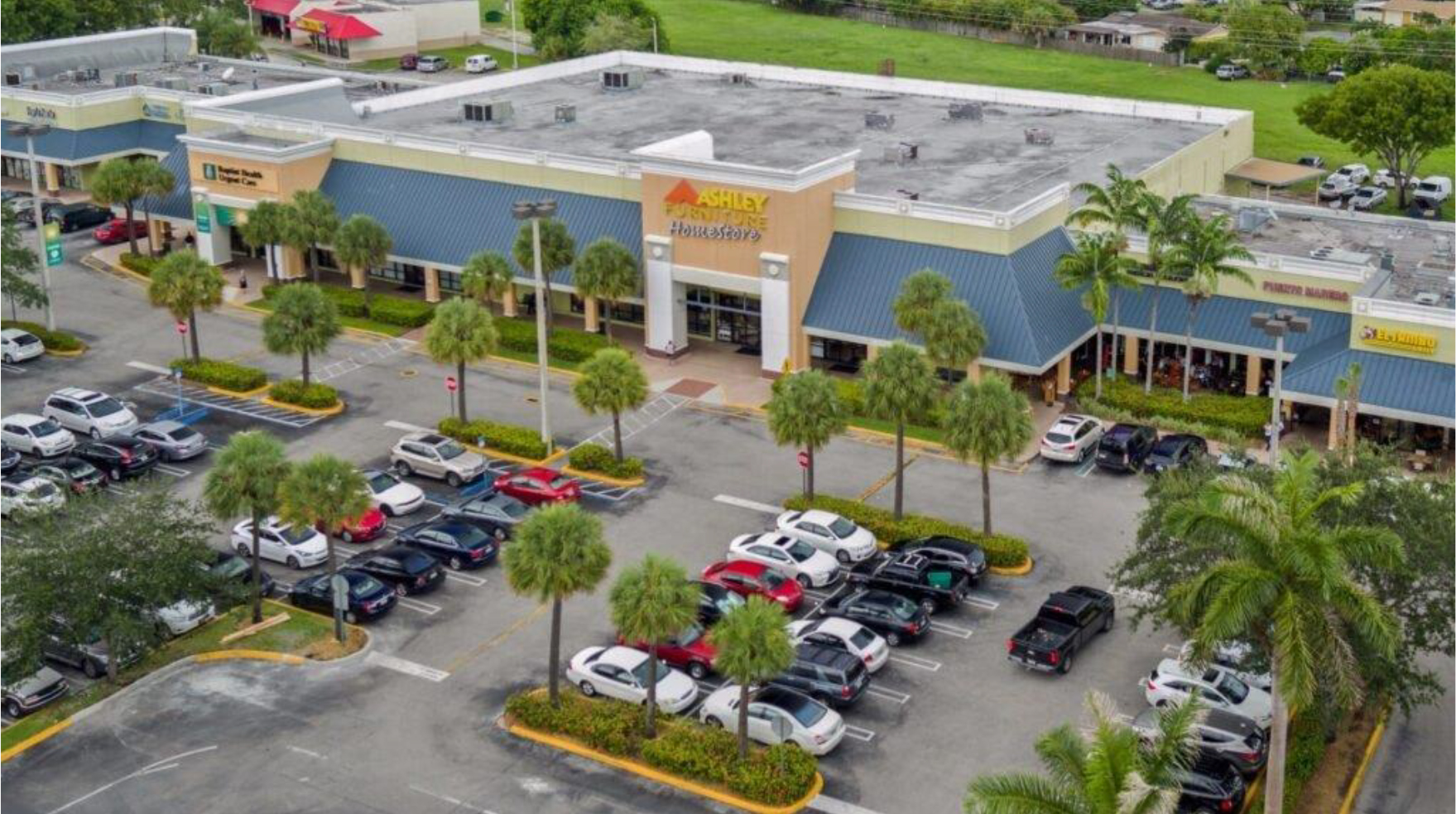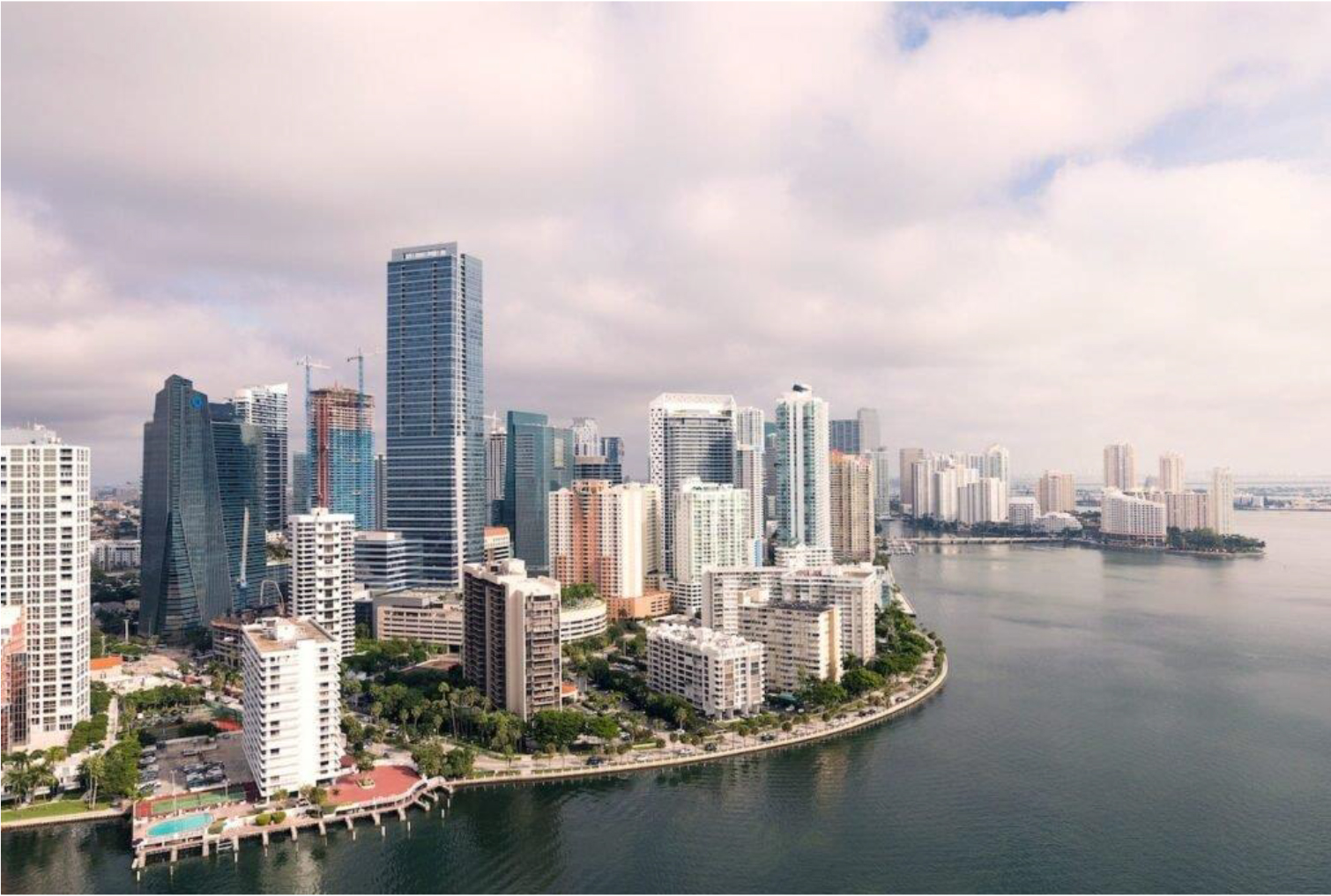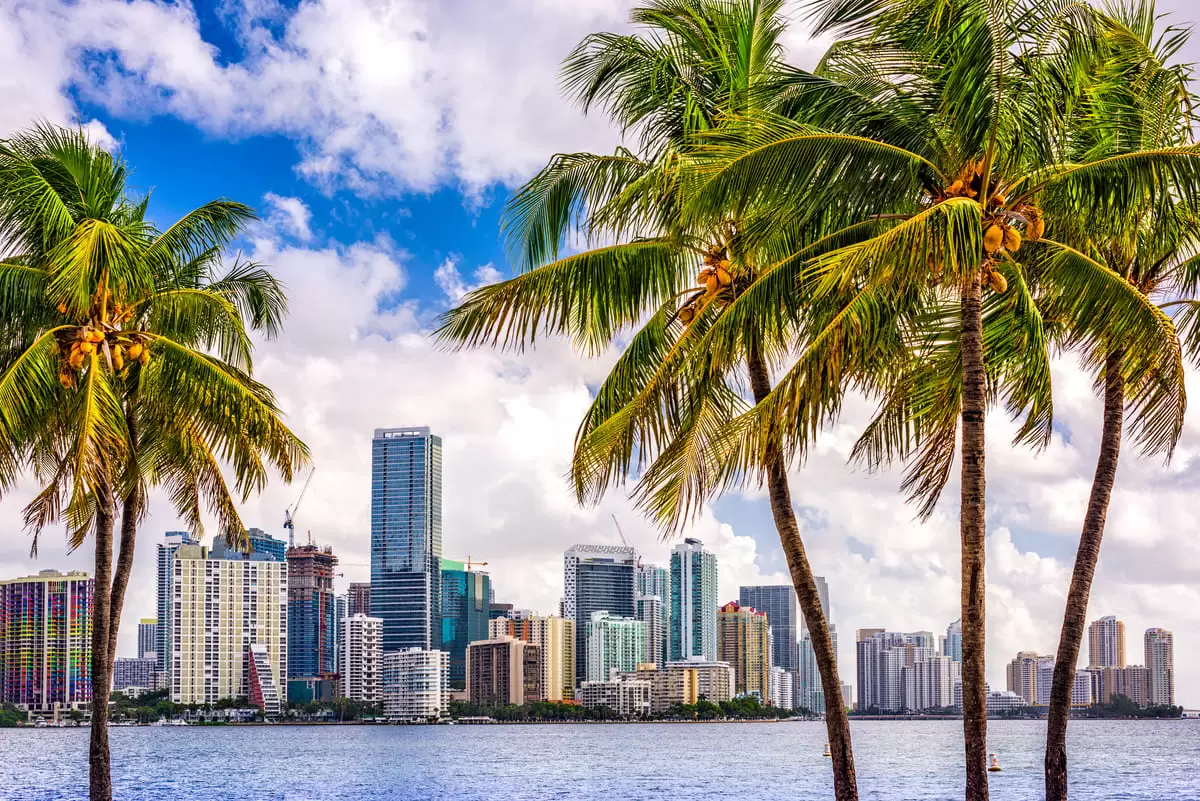On a national and global level, Florida and particularly the South Florida market has been among the strongest, with continually solid returns and safety for the capital of international & domestic investors. US News & World Report currently ranks Florida #8 in fiscal stability and #10 with its economy nationwide.
South Florida commercial real estate leads the way in the wake of the COVID-19 pandemic within the state. It’s supported by consistently strong population growth, tax-friendly laws, continual return of visitors worldwide, and innovative development projects.
It’s not just the population growth that makes it an active and enticing market, but also the high volume of attractive real estate properties, the diverse cultural offerings, and the fact that it’s a travel destination for national and international travelers. With direct transportation access by land, air, and sea, it’s also a central hub for international business, especially in South America.
Florida’s commercial real estate market receives continual, significant investments from global players in China, Canada, Germany, Singapore, Saudi Arabia, and Qatar. This substantial influx of capital coinciding with the current economic conditions provides a solid foundation for why South Florida commercial properties remain a popular place for commercial real estate investment. These factors mentioned above aggregate to continually make it a hot commercial real estate investment opportunity.
Below are the top reasons why South Florida is one of the best commercial real estate markets for investors.
1. Florida’s Fiscal Stability & Economy
As mentioned above, US News & World Report ranked Florida #8 in fiscal stability and #10 with economy compared to the rest of the country. Fiscal stability is highest when assets and policies are in place to mitigate potential economic crises and smoothen the inevitable swings in the economy. The most important factor contributing to this is Florida’s liquidity score, which is 5.8 (total current assets/total current liabilities). That is more than twice the national average of 2.5.
Additionally, the Sunshine State’s economy ranks #10 due to the following factors: job growth and venture capital.
- Job Growth – Florida is #3 nationwide as far as job growth is concerned, with 1.9% job growth year-over-year compared to the national average of 1.2%. Additionally, following the COVID-19 pandemic, September 2021 saw Florida’s job growth rate grow three times faster than the rest of the nation.
- The venture capital funds in the state contribute $17.8 per $1K GDP, which is over 2.5x the national average of $6.77 per $1K GDP
2. Population & Business Growth in South Florida
South Florida has maintained consistent population growth since the early 1900s, according to Worldpopulationreview.com, with an average gain of 2% per year since 2010. While growth has slowed slightly over the last two years, projections are still bullish. Experts estimate that the state’s population will gain six million residents within the next decade to total over 26 million Floridians by 2030.
Miami-Dade County currently has 2,751,796 residents. According to the Miami Herald, it is the 7th largest county in the country behind Los Angeles, Chicago/Cook County, San Diego, Santa Ana/Orange County, Houston/Harris County, and Phoenix/Maricopa County, and followed by Dallas, Brooklyn / Kings County, and Riverside.
Miami now has the 6th fastest growing population nationwide. To put things into perspective, from 2000 to 2010, Miami was not even in the Top 50 fastest-growing regions in the United States. Additionally, Miami ranks among the best nationwide in business growth since 2010 (+2% per year) and 18th for wage growth (+3.3% per year), with both measurements outpacing the national average of 0.7% and 1.9%, respectively.
A growing population and rising incomes pair well for stimulating the economy in any region. These factors combine to create a solid foundation for the continued retail market growth in South Florida.
3. Florida’s Competitive Workforce
Florida’s highly competitive workforce is among the top nationally and globally. Here are some highlights that show why Floridians stand out among the best:
- Fast Company ranked Florida #1 in the country for innovation
- TechAmerica Cyberstates ranks Florida #5 nationwide for high-tech employment
- Florida has the 3rd largest workforce in the United States
- Florida has over 10.5 million civilian workers. Put into perspective, that’s a greater population than Switzerland and nearly the same size as Sweden’s population
- Florida is home to over 6.5 million foreign-language speakers (30.3% of the total population)

4. Growth in the Florida Retail Market
Florida is home to over 270,000 retail stores, and the retail market employs well over two million people (Florida retail accounts for approximately one in five jobs). This is due to people consistently spending their hard-earned dollars at storefronts around the state.
Retail growth in Miami and South Florida has been explosive in recent years. Tech jobs, no income tax, and the sun are some reasons experts believe Florida is poised for continued growth even after the pandemic.
The sunshine state’s lack of a lockdown, attractive house process, and rise in remote working conditions are factors that attract people. The Florida Retail Federation went as far as declaring 2021 as the year of renewed growth for retailers. The expansion of COVID-19 vaccine distribution saw the increase of retail development throughout 2021.
Historically, Miami’s unemployment rate remained below the national average. However, the onset of the global pandemic saw a record spike in unemployment which directly affected the retail sector due to COVID-19 closures. Presently, Florida’s unemployment rate stands at 4.6% in October 2021.
Capital continues to flow into retail and shows no signs of letting up at the moment. These 2020 South Florida retail Shopping Center Transactions further highlight the constant movement of assets into the region’s retail market.
5. Business Incentives in Florida
Florida is attractive to businesses for several reasons. Investors and entrepreneurs flock here to reduce their potential tax burden with no personal income tax, inheritance tax, or estate tax.
According to Chief Executive Magazine, Florida is the #2 rated state for business, and according to Tax Foundation, it is the #1 tax climate in the southeast. Kiplinger ranks it #4 in the nation. For these reasons, 20% of US businesses that export goods are located in Florida.
According to the Commercial Market Conditions Index rankings, the National Association of Realtors (NAR) revealed Florida has five of the top markets in the country with the strongest commercial markets, including office, retail, apartment, industrial, and hotel sectors
NAR’s index rankings measure a metro area’s demographic and economic conditions – for example, wage growth and population growth. It also considers several commercial market indicators, including vacancy rates, leasing, inventory, rents, and sales volume.
NAR’s index, further, shows the following ten metros with the strongest commercial markets in the second quarter of 2021:
- Cape Coral-Fort Myers, FL
- West palm beach-Boca Raton-Delray Beach, FL
- North Point Sarasota-Bradenton, FL
- Punta Gorda, FL
- Las Vegas
- Raleigh, NC
- Nashville
- Olympia Tumwater, WA
- Spokane-Spokane Valley, WA
To further bolster the state’s standing as far as taxes and personal investments are concerned, Retirementliving.com ranks Florida as the #5 most tax-friendly state for retirement. For the same category, Kiplinger ranks it #5 (moved up from #8 in 2017).
Various factors (like the cost of living, tax rates, average income, etc.) help illustrate why Florida is a perennial favorite for business and personal finance.
6. Foreign Investment in Commercial Real Estate
The United States is #1 in Foreign Direct Investment (FDI) worldwide. Specifically, Florida ranks fourth among the top ten US states receiving FDI and has nearly one million jobs supported directly by FDI. Estimates from the Florida Chamber of Commerce show that one in five jobs depends on inward investment, resulting in over 30% higher pay above the state average wage.
In 2017, Florida was the #1 state where foreigners bought and sold commercial property. Furthermore, as of 2015, Florida ranked fourth in the US for cross-border capital flow, as an increasing number of international investors jumped into the real estate market. The investment rate reached a 9-year high in 2016 with $4.3 billion in investment from outside the US flowing, up 85% from 2014.
Many countries have driven that growth, with new investments from Canada, the Netherlands, Luxembourg, Ireland, Spain, Germany, United Arab Emirates, and China. Latin American countries suffering from poor economic performances heavily invest in the South Florida commercial real estate capital haven.
To further illustrate these international investments, Florida’s commercial real estate market presents many opportunities for these investors, with Orlando, Tampa, West Palm Beach, Ft Lauderdale, and Miami as anchoring cities.
Lastly, Buildium.com ranked the top 50 real estate markets for residents and investors in 2019 and included seven of Florida’s real estate markets.

7. Commercial Real Estate in Miami Offers High Yields
Compared to other global gateway cities and existing cultural hubs in the US, the I-90 corridor, and in Europe, South Florida offers comparatively higher yields on investment.
Assets in Florida markets are performed strongly in 2016, with a 10% gain in the first half. Other Florida cities like Orlando, Tampa, and Jacksonville have also been targets due to these higher relative gains. In South Florida, Orlando, Tampa, West Palm Beach, and Miami present a wide range of commercial real estate properties and opportunities for positive returns.
8. Commercial Real Estate Investment Trusts
REITs have significantly impacted the Miami commercial real estate market with low-interest rates and a strong job market. A record 24.2 million people visited Miami in 2019 (16.3 million overnight and 7.9 million day-trippers), and the city’s population has grown by nearly 19.73% since the 2010 census to reach 442,241 thousand people in 2020.
Additionally, the greater Miami-Dade County, FL, has over 2.7 million people. Miami metro totals over 6.1 million residents. The combination of this growth and institutional investment from outside developers has meant more rapid growth than would otherwise be possible and consistent interest in the region.
Commercial real estate is lucrative in Florida and has well-performing investments for domestic and global investors. It continues to generate capital growth as the area grows and flourishes. Whether evaluating Florida NNN (triple net lease) properties for sale or other commercial investment opportunities, there has never been a better time for commercial real estate investments in the region.
9. Forecast Remains Positive for South Florida CRE
Consistent population growth and home building combined with steadily increasing tourism (Florida ranks #2 of all US States) provide a solid foundation for capital to flow into the region’s retail market. Those elements and continual construction projects are positive signs of growth across other commercial real estate sectors.
Unfortunately, the 2020 COVID-19 pandemic negatively affected the CRE sector. However, despite the current pandemic, significant developments are shaping up in the region characterized by sealing property refinances in several locations.
Meanwhile, international and domestic investors continue to contribute to the market, making the overall financial data in the region’s CRE remain optimistic for now. Still, analysts take a cautious long-term approach, a sharp contrast from their previously exhibited bullish behavior towards the CRE.
Some of the recent CRE highlights in the region include South Florida CRE booming, a Broward County record industrial transaction, a new Miami World Center tenant, and more.
Only time will tell, but the overall sentiment regarding South Florida commercial real estate is looking upward and onward.
What’s more, Florida should continue positioning itself as a business-friendly destination even as high-tax states like California and New York continue increasing taxes and regulations. Consequently, Florida will directly benefit from the resultant capital and population migration, a direct boon to the South Florida commercial real estate.

